Citroen C3 RHD 2015 2.G Owner's Manual
Manufacturer: CITROEN, Model Year: 2015, Model line: C3 RHD, Model: Citroen C3 RHD 2015 2.GPages: 324, PDF Size: 9.86 MB
Page 101 of 324

99
Installing child seats attached using the seat beltIn accordance with European regulations, this table indicates the options for installing child seats secured using a seat belt and universally approved (a)
in accordance with the weight of the child and the seat in the vehicle.
Weight of the child and indicative age
Seat Under 13 kg
(groups 0 (b) a n d 0 +)
Up to approx 1 year From 9 to 18 kg
(g r o u p 1)
1 to 3 years approx From 15 to 25 kg
(group 2)
3 to 6 years approx From 22 to 36 kg
(group 3)
6 to 10 years approx
Front passenger
seat (c) (e) U
UUU
ou
ter rear
seats (d) U
UUU
Centre rear
seat (d) U (f )
U (f ) UU
7
Child safety
Page 102 of 324

100
(a) Universal child seat: child seat that can be installed in all vehicles using a seat belt.
(b)
G roup 0: from birth to 10 kg. Shells seats and baby carriers cannot be installed in the front
passenger seat. When installed in the 2
nd row, they may prevent use of the other seats.
(c ) Consult the legislation in force in your country before installing your child on this seat.
(d)
T
o install a child seat on a rear seat, rear ward facing or for ward facing, move the front seats
for ward, then straighten their backrests to allow sufficient space for the child seat and the child’s
legs.
(e)
W
hen a rear ward facing child seat is installed on the front passenger seat , the passenger’s
front airbag must be deactivated. Other wise, the child risks being seriously injured or killed
if the airbag is deployed .
When a for ward facing child seat is installed on the front passenger seat , the passenger’s front
airbag must remain active.
(f ) A child seat with support leg must never be installed on this passenger seat .
U :
S
eat suitable for the installation of a child seat secured using a seat belt and universally
approved, rear ward facing and/or for ward facing. Remove and stow the head restraint
before installing a child seat with a
backrest on a passenger seat. Refit the
head restraint once the child seat has
been removed.
Child safety
Page 103 of 324
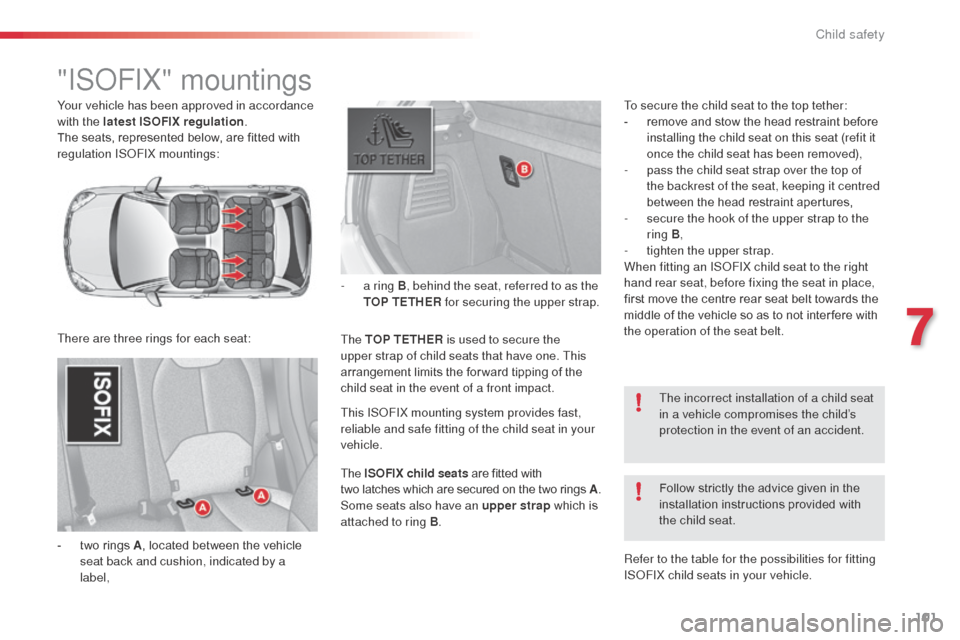
101
Your vehicle has been approved in accordance
with the latest ISOFIX regulation.
The seats, represented below, are fitted with
regulation IS
oF
IX mountings:
-
t
wo rings A , located between the vehicle
seat back and cushion, indicated by a
label, The TOP TETHER is used to secure the
upper strap of child seats that have one. This
arrangement limits the for ward tipping of the
child seat in the event of a front impact. -
a r
ing B, behind the seat, referred to as the
TOP TETHER for securing the upper strap.
Follow strictly the advice given in the
installation instructions provided with
the child seat.
"ISoFIX" mountings
The incorrect installation of a child seat
in a vehicle compromises the child’s
protection in the event of an accident.
There are three rings for each seat: To secure the child seat to the top tether:
-
r
emove and stow the head restraint before
installing the child seat on this seat (refit it
once the child seat has been removed),
-
p
ass the child seat strap over the top of
the backrest of the seat, keeping it centred
between the head restraint apertures,
-
s
ecure the hook of the upper strap to the
ring B ,
-
t
ighten the upper strap.
When fitting an IS
oF
IX child seat to the right
hand rear seat, before fixing the seat in place,
first move the centre rear seat belt towards the
middle of the vehicle so as to not inter fere with
the operation of the seat belt.
Refer to the table for the possibilities for fitting
IS
oF
IX child seats in your vehicle.
This ISoF
IX mounting system provides fast,
reliable and safe fitting of the child seat in your
vehicle.
The ISOFIX child seats are fitted with
two
l
atches which are secured on the two rings A.
Some seats also have an upper strap which is
attached to ring B .
7
Child safety
Page 104 of 324
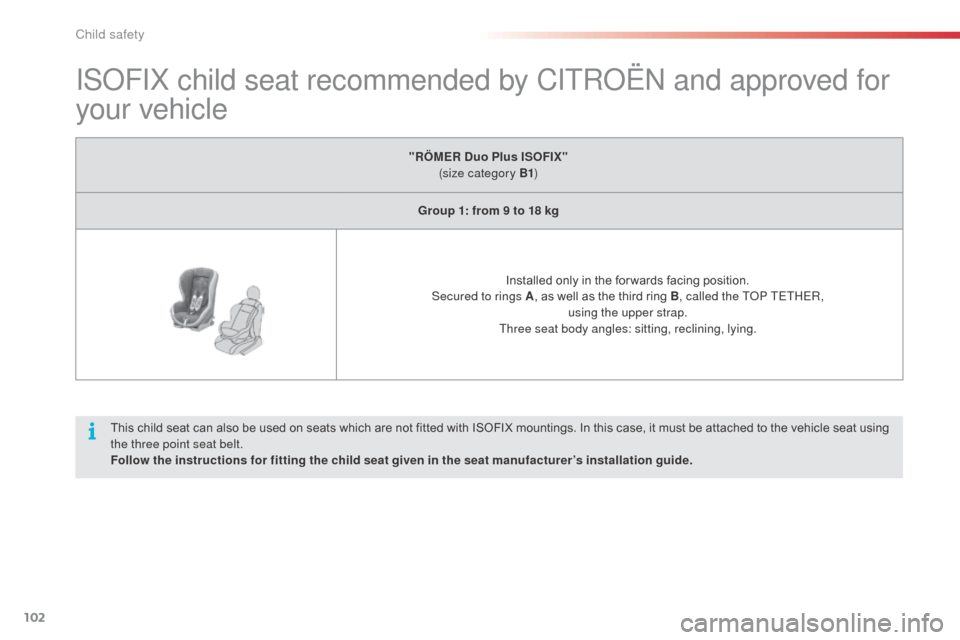
102
ISoFIX child seat recommended by CITRoËn and approved for
your vehicle
This child seat can also be used on seats which are not fitted with ISOFIX mountings. In this case, it must be attached to the vehicle seat using
the three point seat belt.
Follow the instructions for fitting the child seat given in the seat manufacturer’s installation guide. "
RÖMER Duo Plus ISOFIX"
(size category B1 )
Group 1: from 9 to 18 kg
Installed only in the for wards facing position.
Secured to rings A , as well as the third ring B, called the T
oP T
ETHER,
using the upper strap.
Three seat body angles: sitting, reclining, lying.
Child safety
Page 105 of 324
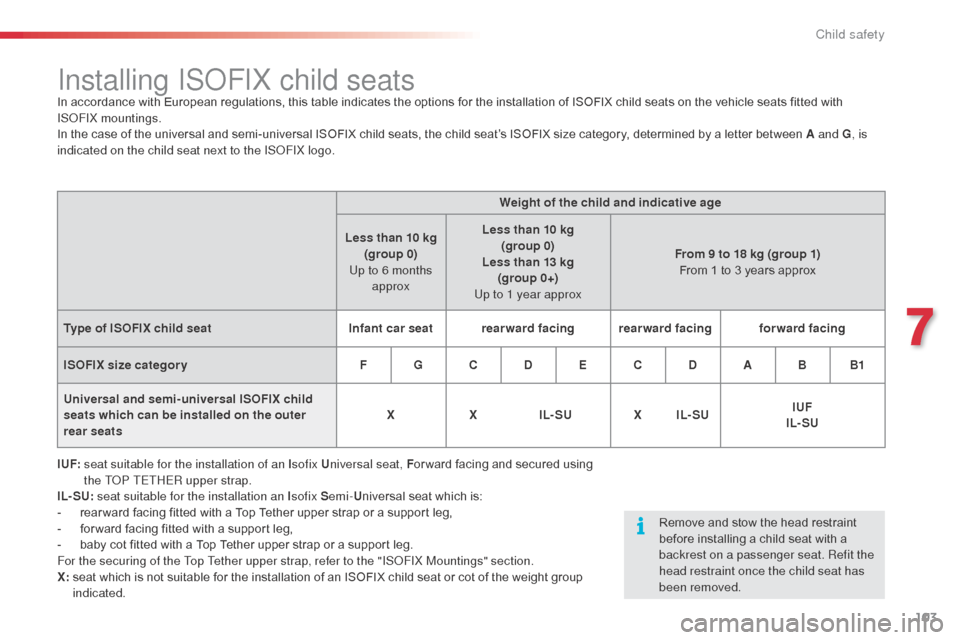
103
Installing ISoFIX child seatsIn accordance with European regulations, this table indicates the options for the installation of ISOFIX child seats on the vehicle seats fitted with
ISoF
IX mountings.
In the case of the universal and semi-universal ISOFIX child seats, the child seat’s ISOFIX size category, determined by a letter between A and G , is
indicated on the child seat next to the IS
oF
IX logo.
I UF:
s
eat suitable for the installation of an I sofix Universal seat, F or ward facing and secured using
the T
oP T
ETHER upper strap.
IL- SU: seat suitable for the installation an I sofix Semi-Universal seat which is:
-
r
ear ward facing fitted with a Top Tether upper strap or a support leg,
-
f
or ward facing fitted with a support leg,
-
b
aby cot fitted with a Top Tether upper strap or a support leg.
For the securing of the Top Tether upper strap, refer to the "IS
oF
IX Mountings" section.
X:
s
eat which is not suitable for the installation of an ISOFIX child seat or cot of the weight group
indicated. Weight of the child and indicative age
Less than 10 kg (group 0)
Up to 6 months approx Less than 10 kg
(group 0)
Less than 13 kg (group 0+)
Up to 1 year approx From 9 to 18 kg (group 1)
From 1 to 3 years approx
Type of ISOFIX child seat Infant car seatrearward facing rearward facing forward facing
ISOFIX size categor y F G C D E C D A B B1
Universal and semi-universal ISOFIX child
seats which can be installed on the outer
rear seats X
XIL- SU XIL- SU IUF
IL- SU
Remove and stow the head restraint
before installing a child seat with a
backrest on a passenger seat. Refit the
head restraint once the child seat has
been removed.
7
Child safety
Page 106 of 324

104
The chest part of the seat belt must be
positioned on the child’s shoulder without
touching the neck.
Ensure that the lap part of the seat belt
passes correctly over the child’s thighs.
CITR
oËn
recommends the use of a booster
seat which has a back, fitted with a seat belt
guide at shoulder level.
as a s
afety precaution, do not leave:
-
a c
hild or children alone and
unsupervised in a vehicle,
-
a c
hild or an animal in a vehicle which
is exposed to the sun, with the windows
closed,
-
t
he keys within reach of children inside
the vehicle.
To prevent accidental opening of the doors
and rear windows, use the child lock.
Take care not to open the rear windows by
more than one third.
To protect young children from the rays of
the sun, fit side blinds on the rear windows.
Children at the front Installing a booster
seat
The legislation on carrying children on the
front passenger seat is specific to each
country. Refer to the legislation in force in
your country.
Deactivate the passenger airbag when a
rear ward facing child seat is installed on the
front seat.
Otherwise, the child risks being seriously
injured or killed if the airbag is deployed.For optimum installation of the forward facing
child seat, ensure that the back of the child
seat is as close as possible to the backrest
of the vehicle’s seat, in contact if possible.
You mst remove the head restraint before
installing a child seat with backrest to a
passenger seat.
Ensure that the head restraint is stored or
attached securely to prevent it from being
thrown around the vehicle in the event of
sharp braking. Refit the head restraint when
the child seat is removed.
The incorrect installation of a child seat in a
vehicle compromises the child’s protection in
the event of an accident.
Ensure that there is no seat belt or seat belt
buckle under the child seat, as this could
destabilise it.
Remember to fasten the seat belts or the
child seat harnesses keeping the slack
relative to the child’s body to a minimum,
even for short journeys.
When installing a child seat using the seat
belt, ensure that the seat belt is tightened
correctly on the child seat and that it secures
the child seat firmly on the seat of your
vehicle. If your passenger seat is adjustable,
move it for wards if necessary.
At rear seating positions, always leave
sufficient space between the front seat and:
-
a r
ear ward facing child seat,
-
t
he child’s feet for a child seat fitted
forward facing.
To do this, move the front seat for wards
and, if necessary, move its backrest into the
upright position.
advice on child seats
Child safety
Page 107 of 324
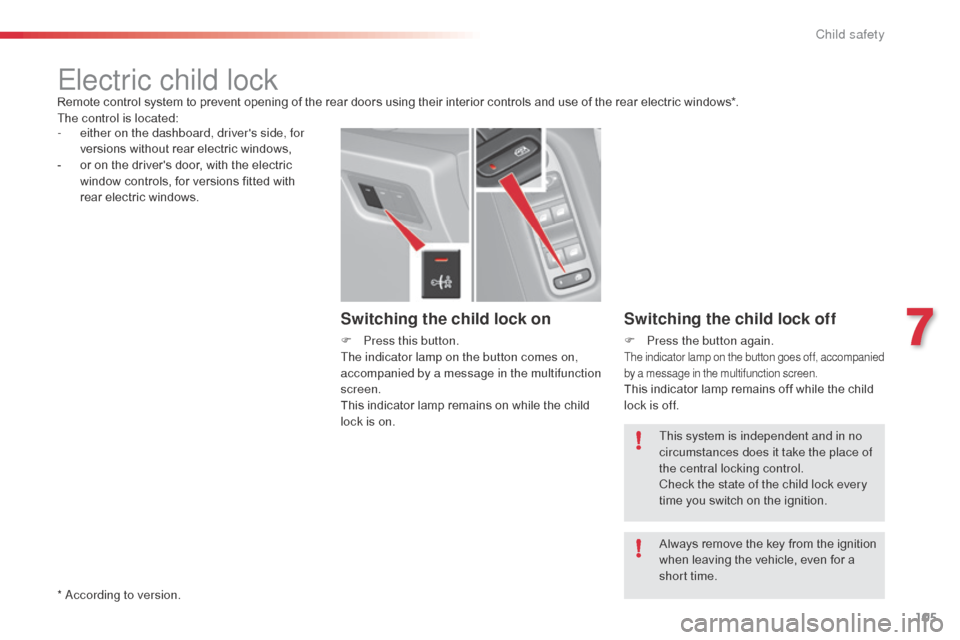
105
Electric child lockRemote control system to prevent opening of the rear doors using their interior controls and use of the rear electric windows*.
The control is located:
Switching the child lock on
F Press this button.
The indicator lamp on the button comes on,
accompanied by a message in the multifunction
screen.
This indicator lamp remains on while the child
lock is on.
Switching the child lock off
F Press the button again.The indicator lamp on the button goes off, accompanied
by a message in the multifunction screen.
This indicator lamp remains off while the child
lock is off.This system is independent and in no
circumstances does it take the place of
the central locking control.
Check the state of the child lock every
time you switch on the ignition.
Always remove the key from the ignition
when leaving the vehicle, even for a
short time.
-
e
ither on the dashboard, driver's side, for
versions without rear electric windows,
-
o
r on the driver's door, with the electric
window controls, for versions fitted with
rear electric windows.
*
a
c
cording to version.
7
Child safety
Page 108 of 324
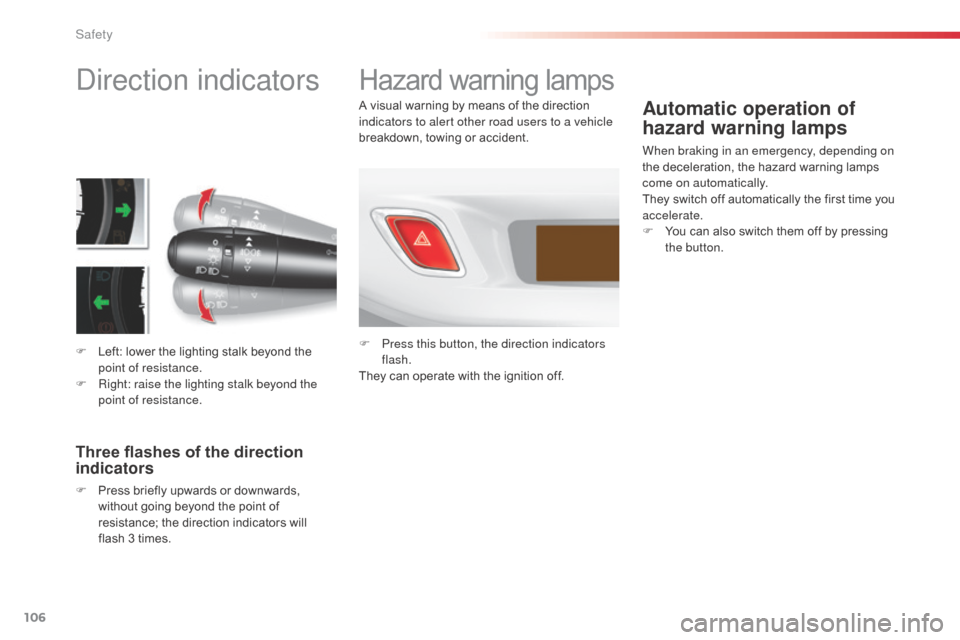
106
direction indicators
F Left: lower the lighting stalk beyond the point of resistance.
F
R
ight: raise the lighting stalk beyond the
point of resistance.
Three flashes of the direction
indicators
F Press briefly upwards or downwards, without going beyond the point of
resistance; the direction indicators will
flash 3 times.
Hazard warning lamps
F Press this button, the direction indicators flash.
They can operate with the ignition off.
Automatic operation of
hazard warning lamps
When braking in an emergency, depending on
the deceleration, the hazard warning lamps
come on automatically.
They switch off automatically the first time you
accelerate.
F
Y
ou can also switch them off by pressing
the button.
A visual warning by means of the direction
indicators to alert other road users to a vehicle
breakdown, towing or accident.
Safety
Page 109 of 324
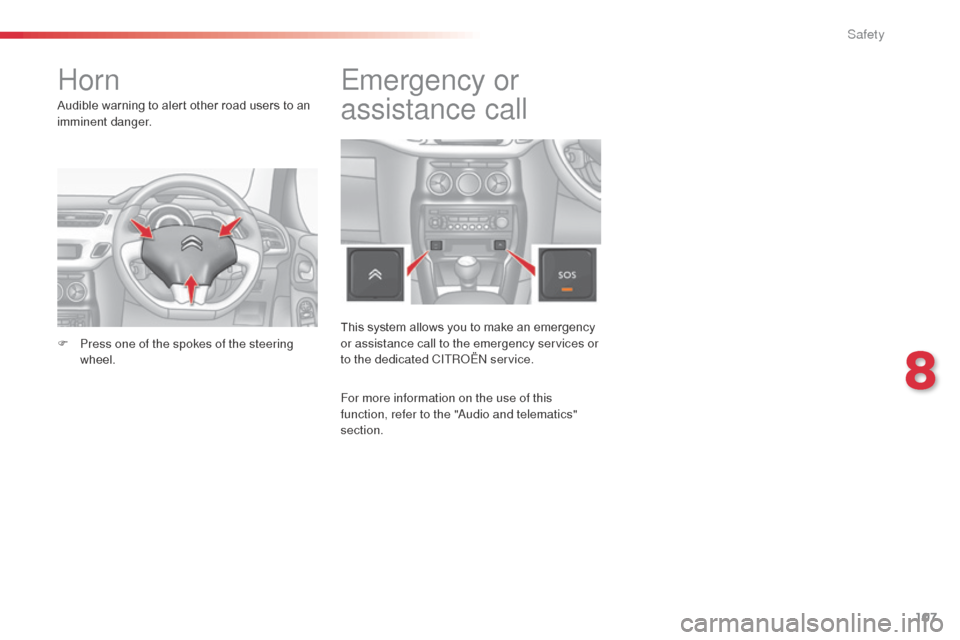
107
Horn
Audible warning to alert other road users to an
imminent danger.
F
P
ress one of the spokes of the steering
wheel.
Emergency or
assistance call
This system allows you to make an emergency
or assistance call to the emergency services or
to the dedicated CITR
oËn
service.
For more information on the use of this
function, refer to the "
au
dio and telematics"
section.
8
Safety
Page 110 of 324

108
Under-inflation detection
System which automatically checks the pressures of the tyres while driving.
The system monitors the pressures in the four
tyres, once the vehicle is moving.
It compares the information given by the four
wheel speed sensors with reference values,
which must be reinitialised ever y time the
tyre pressures are adjusted or a wheel
changed.
The system triggers an alert as soon as it
detects a drop in the inflation pressure of one
or more tyres. The under-inflation detection system
does not replace the need for vigilance
on the part of the driver.
This system does not avoid the need to
check the tyre pressures (including the
spare wheel) every month as well as
before a long journey.
Driving with under-inflated tyres impairs
road holding, extends braking distances
and causes premature tyre wear,
particularly under arduous condition
(high loading, high speed, long journey).The inflation pressures defined for
your vehicle can be found on the tyre
pressure label.
See the "Identification markings"
section.
Tyre pressures should be checked
when the tyres are "cold" (vehicle
stopped for 1 hour or after a journey of
less than 6 miles (10 km) at moderate
speeds).
Other wise (when hot), add 0.3 bar to
the pressures shown on the label.
Driving with under-inflated tyres
increases fuel consumption.
Safety